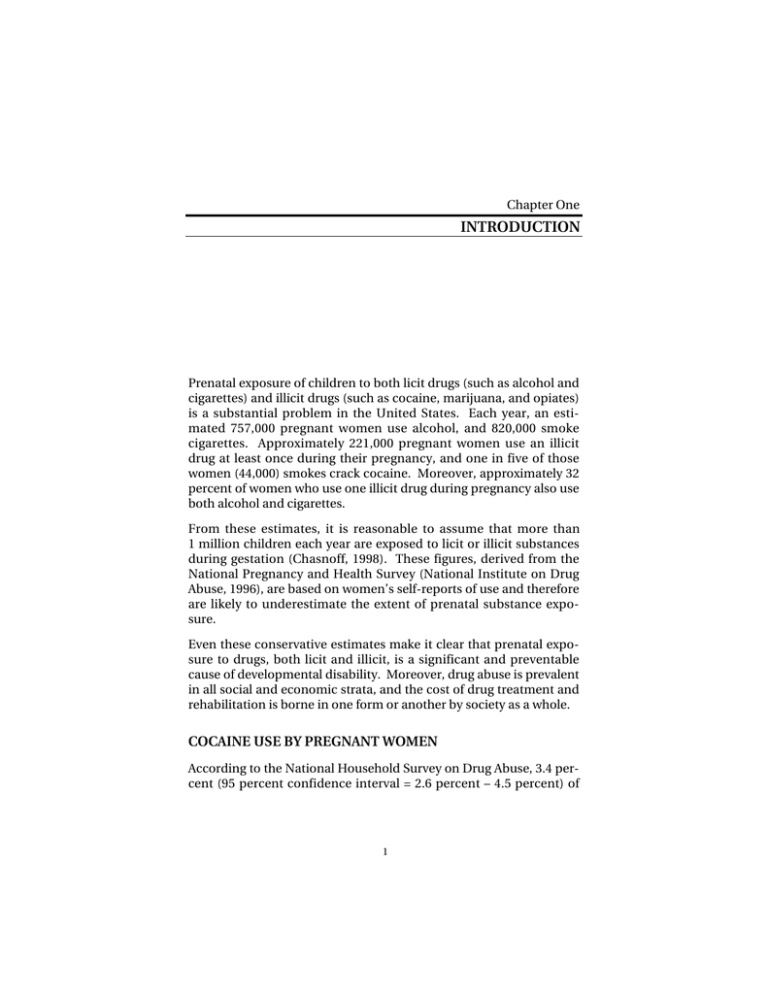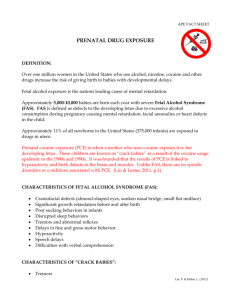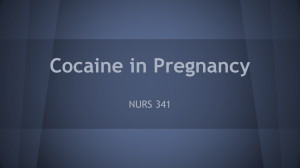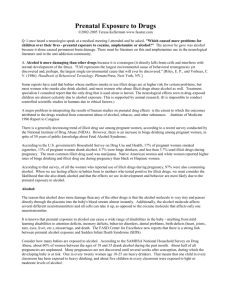INTRODUCTION
advertisement

Chapter One INTRODUCTION Prenatal exposure of children to both licit drugs (such as alcohol and cigarettes) and illicit drugs (such as cocaine, marijuana, and opiates) is a substantial problem in the United States. Each year, an estimated 757,000 pregnant women use alcohol, and 820,000 smoke cigarettes. Approximately 221,000 pregnant women use an illicit drug at least once during their pregnancy, and one in five of those women (44,000) smokes crack cocaine. Moreover, approximately 32 percent of women who use one illicit drug during pregnancy also use both alcohol and cigarettes. From these estimates, it is reasonable to assume that more than 1 million children each year are exposed to licit or illicit substances during gestation (Chasnoff, 1998). These figures, derived from the National Pregnancy and Health Survey (National Institute on Drug Abuse, 1996), are based on women’s self-reports of use and therefore are likely to underestimate the extent of prenatal substance exposure. Even these conservative estimates make it clear that prenatal exposure to drugs, both licit and illicit, is a significant and preventable cause of developmental disability. Moreover, drug abuse is prevalent in all social and economic strata, and the cost of drug treatment and rehabilitation is borne in one form or another by society as a whole. COCAINE USE BY PREGNANT WOMEN According to the National Household Survey on Drug Abuse, 3.4 percent (95 percent confidence interval = 2.6 percent – 4.5 percent) of 1 2 Prenatal Cocaine Exposure: Scientific Considerations and Policy Implications the women in the United States between the ages of 18 and 25 reported using cocaine during 1998 (Substance Abuse and Mental Health Services Administration, 1999). Although it is difficult to quantify the use of cocaine by pregnant women, one study found it to be the most prevalent drug to which foster-care children had been exposed before birth. Between 1986 and 1991, the two years studied, the exposure incidence jumped from 17 percent to 55 percent of young foster-care children. The study also found that about 25 percent of the children in the 1991 study had been exposed in utero to more than one substance (U.S. General Accounting Office, 1997). Cocaine is water-soluble; it can be taken orally or intravenously, or vapors of the freebase alkaloid known as crack cocaine can be inhaled. Cocaine administered by any of these routes has a strong effect on the nervous system (Chiriboga, 1998; Koren et al., 1998). It works by blocking the reuptake, or reabsorption, of certain chemicals called neurotransmitters which serve as messengers in the transmission of signals throughout the nervous system. In particular, the drug interferes with the reuptake of three neurotransmitters: dopamine, serotonin, and norepinephrine. These neurotransmitters form the monoaminergic system, which directly affects communication in other systems throughout the brain. In addition, enzymes in the body convert cocaine to its metabolites, which may have independent toxic effects on the nervous system. Cocaine and its metabolites pass readily through the placenta to the fetus (Chiriboga, 1998), but the precise way in which cocaine affects the developing fetus is not fully understood. The neurotransmitters that make up the monoaminergic systems also have a maturational function in determining how tissues, including the brain, mature during development. To the extent that these maturational signals are interrupted by cocaine use, other deficits in the fetus may also occur. PRENATAL COCAINE EXPOSURE AND POLICY INTERVENTIONS Most interventions to address the problem of prenatal substance exposure have been directed at preventing the problem in the first place. For example, significant resources have been devoted to edu- Introduction 3 cating women about the dangers of smoking and drinking during pregnancy. These educational efforts have been supplemented with legislation mandating warning labels on cigarettes and alcohol. Steps have also been taken to educate women about the dangers of using illicit substances such as cocaine during pregnancy. The nation has made a strong effort to reduce the use of illicit drugs by making their trade, sale, and use a criminal offense (Rydell and Everingham, 1994). Unfortunately, such prevention efforts have not been completely successful, and as the statistics above illustrate, approximately 1 million babies each year are affected by prenatal substance use. Little public attention was given to women with substance-abuse problems until the late 1970s, when the impact of prenatal alcohol exposure on children received wide publicity. Stories in the popular press in the late 1980s provided pessimistic descriptions of children exposed to cocaine in utero, dubbed “crack babies,” suggesting that they were significantly and permanently disabled (Cosden et al., 1997; Elliott and Coker, 1991; Richardson, 1998). Follow-up studies have shown that the deficits are more subtle than initially feared; however, some of the children do have a host of learning and behavioral problems (Harvey and Kosofsky, 1998). Thus, policy approaches must be developed that address not only prevention of substance use during pregnancy but also the concerns of children born with drug-associated problems. Drawing from the field of public health, the policy approaches that address prenatal substance exposure may be conceptualized as a spectrum of interventions ranging from primary prevention to secondary and tertiary prevention. Primary prevention, aimed at preventing the initial occurrence of a problem, refers to preventing substance use during pregnancy or avoiding pregnancy while using substances. Secondary prevention, aimed at minimization of problems when a risk factor already exists, refers to identifying pregnant women who are abusing drugs and minimizing their use of such substances. Tertiary prevention, aimed at minimizing the postexposure consequences of a problem, refers to reducing the adverse consequences of substance exposure in infants and children who have been exposed in utero. Given the medical, psychological, and social complexities of drug use, it appears likely that a combination of 4 Prenatal Cocaine Exposure: Scientific Considerations and Policy Implications strategies focusing on all aspects of prevention will be needed to combat the full range of problems related to prenatal drug exposure. Options for intervention include treatment and research in addition to educational and legislative strategies. These four approaches are generally applied with different emphases. For example, educational interventions for primary prevention would focus on women of childbearing age or on other members of the community who have an effect on these women’s behavior. Educational intervention for secondary prevention would focus on health-care providers such as gynecologists, obstetricians, and other professionals who deal with pregnant women and their developing fetuses. And in tertiary prevention, the focus of educational interventions would be on pediatricians, educators, child-care workers, and others who provide social services to the affected children. These options are interrelated and interdependent. Basic research interventions drive and inform education, treatment, and legislative interventions. For example, without substantial research showing the adverse effects of cigarette smoking on the fetus during pregnancy, there would no basis for pursuing educational efforts to discourage mothers from smoking or for mandating warning labels on cigarette packages regarding the connection between smoking and pregnancy. Basic research is also the driving force behind treatment interventions—the nicotine patch was developed through research on the psychopharmacology of smoking. This report focuses on cocaine, but it is nearly impossible to separate the impact of cocaine on a fetus from other factors—including poverty and multiple drug use—that are often associated with cocaine use and that affect the outcomes of exposed children. For this reason, whenever possible, we discuss policy recommendations concerning cocaine and its associated issues within the context of the environment and other influencing factors. FOCUS AND STRUCTURE OF THE REPORT This report discusses prenatal exposure to cocaine, options for intervention, and areas that deserve more research and additional resources. A particular focus is prevention strategies in areas to which, until recently, only limited attention has been paid. Our discussion Introduction 5 is informed by recent animal and clinical research in biomedical and social sciences, results of which were presented at a conference on “Cocaine: Effects on the Developing Brain,” held under the auspices of the New York Academy of Sciences (NYAS) (Harvey and Kosofsky, 1998). This report also discusses the social science research of Gail Zellman and colleagues from RAND regarding the ways in which the healthcare system deals with prenatal substance exposure (Zellman, 1997; Zellman and Bell, 1990; Zellman et al., 1992, 1993, 1997). These investigators, in a study sponsored by the National Institute on Drug Abuse, performed the first national survey of hospital and physician response to prenatal substance exposure. They received completed surveys from more than 1,000 obstetricians and pediatricians who treat newborns. They also surveyed nurse managers and administrators at the hospitals where those physicians practiced to obtain information on nurses’ responses and hospital protocols relating to prenatal substance exposure. Although many questions concerning prenatal cocaine exposure remain unanswered, the information available to date provides a sound foundation for a series of policy interventions aimed at addressing the problem. It is our hope that this report will provide general guidance to decisionmakers seeking to implement these policy interventions.






